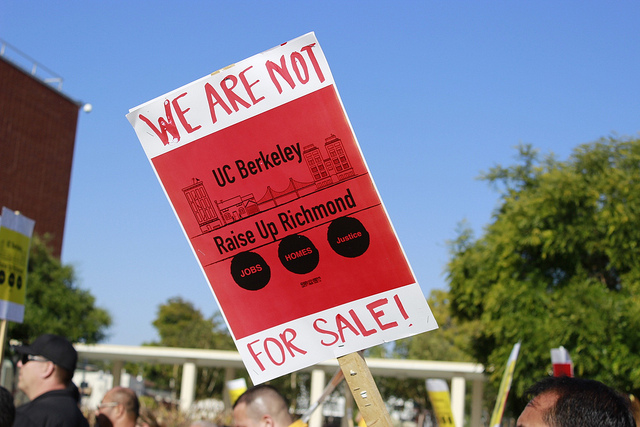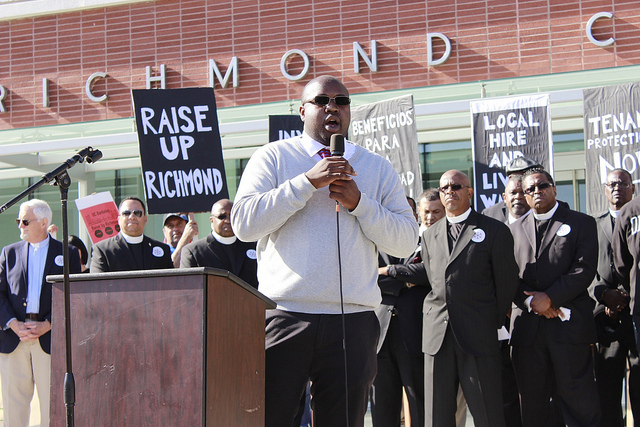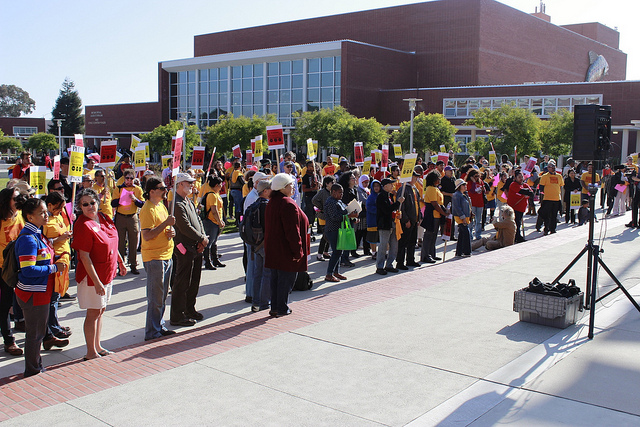
While San Francisco gentrification has garnered ample national press coverage, there is one other Bay Area city experiencing a similar phenomenon – Richmond, California.
Richmond has long been known for three c’s – crime, corruption, and Chevron (the city is home to the company’s century-old refinery). For years, Richmond had soaring violent crime rates, leading politicians and pundits to deem it a national “murder capital.” Additionally, its city council was run by Chevron cronies.
However, Richmond’s homicide rate is now at an historic low – the lowest in over 30 years – and a progressive coalition has been running the city council for about a decade. In fact, even though Chevron pumped $3 million into Richmond’s City Council election last year, Chevron’s favored candidate, Nat Bates, lost to Democrat Tom Butt.
On top of that, Richmond Police Chief Chris Magnus has openly expressed support for the Black Lives Matter movement and has significantly restricted lethal force in Richmond’s police department, which has resulted in Richmond police not killing anyone between 2007 and late 2014 – a very rare trend in police departments. However, in September 2014, one unarmed person, Richard Perez, was killed by a Richmond police officer.
These changes, of course, all make Richmond a better place to live for current residents. On the flipside, the changes have resulted in Richmond attracting rich investors and development projects that could lead to the displacement of current residents. When gentrification in a city makes headlines, the process is usually already happening – high rents, displacement, and a radically changed cultural environment have gained a foothold – and the city is past its breaking point.
A good example is San Francisco: When the national press caught attention of protests against gentrification in San Francisco last year, it was arguably too late for a reversal to occur. Now the city is so far past the breaking point that only the rich can afford to live there. Gentrification in its early stages rarely gets much attention, and this is why it’s so important to focus on places like Richmond. Richmond exemplifies what gentrification looks like at the beginning – and what can be done to mitigate it.
Last month, hundreds of people gathered at Richmond City Hall to rally in support of a legally binding community benefits agreement with the proposed UC Berkeley Global Campus that will be built in Richmond, which sits at Berkeley’s north. The rally was organized by the Raise Up Richmond coalition, which includes a range of local organizations, including advocacy groups, faith groups and unions.
Community benefits agreements are contracts signed by community groups and real estate developers that promise amenities and support for the community in exchange for supporting an impending development project. In San Francisco, for example, tech companies like Spotify, Twitter, and Zendesk signed community benefits agreements as a requirement for tax breaks those companies received from the city. However, many residents complain that those agreements are often meaningless: They hardly do anything to help the community, and meanwhile, gentrification moves forward unfettered.
In October 2014, University of California Chancellor Nicholas Dirks laid out a sprawling vision for the “Berkeley Global Campus” (BGC): an extension campus on 134 acres of land UC Berkeley owns in Richmond. The campus will be 5.5 million square feet and similar to the international extension campuses that US universities build abroad – except it will be 10 miles away from Berkeley. When laying out the project, Dirks said the BCG will be “a new form of international hub where an exclusive group of some of the world’s leading universities and high-tech companies will work side-by-side with us in a campus setting.”
The BCG will emphasize research and education “with both undergraduate and graduate-level academic programs for US and international students,” according to a UC Berkeley Public Affairs article. The Contra Costa Times reported that the “new campus is expected to bring 2,700 temporary construction jobs and 10,000 full-time jobs as well as workforce training and educational partnerships with local schools.”
Even though many Richmond residents don’t disapprove of the UC Berkeley extension campus, they are concerned that people will be displaced if no legally binding community benefits agreement is put in place. Richmond Mayor Tom Butt, in response to criticisms of the project, wrote that UC Berkeley would enter into a legally binding community benefits agreement but that “it is premature to force the issue right now.”
At the rally, Richmond resident Juan Rodriguez spoke about how his landlord recently increased his apartment’s rent by $200 a month. “Back in February, we [apartment tenants] woke up with a letter that the manager posted on the door,” said Rodriguez, a maintenance worker who has lived in his apartment in Richmond’s Iron Triangle neighborhood for three years.
“It wasn’t a pleasant one,” he said of the letter. “It was an increase for $200. So we used to pay $1,000. Now, the rent increase was to $1,200. I was really concerned because I don’t make a lot of money. None of these families make a lot of money.” He explained that a 20 percent increase in rent hurts working-class families in the neighborhood since more of it will go to rent and less to groceries and to raising their children.
Rodriguez also said that his apartment and others in the area are in bad condition: He mentioned mold in ceilings, broken heaters, serious plumbing problems. “As a matter of fact, the ceiling in our bathroom just collapsed due to the bad plumbing,” he said.
In response, Rodriguez and other neighbors in the area organized, joined forces with the Alliance of Californians for Community Empowerment (ACCE), and put pressure on the landlord and city council to stop the 20 percent rent increase. As a result, the landlord agreed to reduce the rent increase from $200 a month down to $150. Rodriguez said that increase is still steep and that several families in the area “struggle every month to pay their rent” and meet their needs; such an increase could mean a displacement from the neighborhood.
Kimberly Gamboa, a Richmond native formerly incarcerated (she served six months in jail for spanking her child), explained to Truthout how she felt about the BGC. “I like the idea,” she said, “but UC Berkeley needs to make sure that they have a legally binding [community benefits] agreement with the City of Richmond to keep the residents of Richmond here in Richmond.”
Gamboa also said that the BGC must be committed to employing residents and educating young people “so that they can get entry-level positions that turn into great-paying careers.” She also argued that any proposed agreement should “incorporate formerly incarcerated people, as well, not just offer us janitorial positions, or food service positions, or gardening, or parking lot attendants” jobs, so they can also find good-paying jobs and meaningful careers.
While construction has yet to begin for the Berkeley Global Campus, it does seem to be a harbinger of gentrification in Richmond, sparking the concerns of community members. Those concerns are not misplaced, according to a recent UC Berkeley study.
Gentrification Creeping in Richmond
 An activist speaks at the Anti-Displacement Rally in Richmond, California, June 4, 2015. (Photo: Adam Hudson)
An activist speaks at the Anti-Displacement Rally in Richmond, California, June 4, 2015. (Photo: Adam Hudson)
A study by UC Berkeley’s Haas Institute for a Fair and Inclusive Society, released in February, concluded that many parts of Richmond – which has a population of more than 107,000 people – are already experiencing early to middle stages of gentrification. The study parses through census “Block Groups” in Richmond, which are “a set of boundaries created by the US Census that in Richmond have an average population of 1,428 residents,” and analyzes the demographic and housing market changes in the city from 2000 to 2013. As the housing market heats up in Richmond and throughout the East Bay, the city’s low-income, renters, and Black and Brown households are vulnerable to displacement.
The study says that vulnerable populations have at least three of four rates that are higher than the city average: “renter-occupied households, people of color, residents with less than bachelor degree education, and households earning less than 80 percent median family income.”
Neighborhoods falling under this category are parts of Hilltop, North and East, and Richmond Annex. These communities will feel displacement the hardest. Richmond’s rising housing market is largely thanks to investors buying property. Local news website Richmond Confidential reported in 2013 that rich investors with loads of cash are increasingly buying property in Richmond. Half of all homes sold in Richmond between 2009 and 2012 were bought by cash buyers, the site notes.
According to the Haas study, “In Richmond, there are 3,770 households that earn less than $20,000 annually and spend more than 30 percent of their income on housing. … Another 3,000 households spend 30 percent of income on housing and earn between $20,000 and $34,999.” The real estate website Zillow calculated that at the end of May 2015, median home value in Richmond was $324,500, and home values had gone up 17.8 percent over the past year. Zillow predicts that home values in Richmond will rise by 7.4 percent within the next year.
While Richmond is a majority non-white city, communities of color are most concentrated in the north, central and southern parts of the city. The city’s African-American population is higher in “areas of Hilltop, Parchester Village, North Richmond, Iron Triangle and South Richmond.”
However, Richmond’s Black population has recently declined. According to the US Census, Richmond’s Black population was 47.9 percent in 1980 and 43.8 percent in 1990 but dropped to 26.6 percent in 2010. According to the Haas study, between 2000 and 2013, Richmond’s Black population dropped by 12,500, which is a 35 percent decrease. The reasons for this decline include the prevalence of violent crime that made Richmond one of the country’s murder capitals, “lack of jobs and foreclosures that disproportionately affected the African-American community,” reported the Contra Costa Times.
Low-income and renter households are also highly concentrated in those areas. Almost all Block Groups in the neighborhoods of North Richmond, Iron Triangle, Richmond Annex, along with “nearly half” of those in the North and East and Hilltop “have percentages of low-income households that are above 50 percent, higher than the city average.” Additionally, “North Richmond, most of the central and south Richmond areas, and other areas have a higher concentration of renters than the city as a whole, with some areas above 80 percent renters,” according to the study. Moreover, these neighborhoods have large populations of people without a bachelors degree or higher. On top of that, median household income dropped 15 percent between 2000 and 2013, which is “twice the rate of Oakland and far more severe than El Cerrito and Berkeley.” On top of that, the housing market activity is increasing the most in those north, central and southern parts of Richmond – the areas most vulnerable to gentrification.
Some areas – like all of Parchester Village and North Richmond and parts of El Sobrante Hills, Richmond Annex, North and East, Iron Triangle, and Marina Bay – show “gentrification-related demographic change,” which means an increasing number of homeowner-occupied (rather than renter-occupied) households, growing median household income, and higher percentages of white people and adults of a bachelor degree or above.
What To Do
 Protesters gather at the Anti-Displacement Rally in Richmond, California, June 4, 2015. (Photo: Adam Hudson)
Protesters gather at the Anti-Displacement Rally in Richmond, California, June 4, 2015. (Photo: Adam Hudson)
The acceleration of gentrification isn’t inevitable: According to the Haas Institute study, Richmond has the opportunity to mitigate the impact of gentrification by quickly implementing anti-displacement policies. However, no one has a definite answer as to what constitutes an effective “anti-displacement policy.” Eli Moore, one of the study’s authors, told Richmond Confidential, “In Richmond you have a situation where there’s no regulation that governs under what conditions people can be evicted.”
While cities like San Francisco and Oakland have “just cause” eviction policies that govern when a tenant can be rightfully evicted, Richmond does not. “They also don’t have rent stabilization, whereas San Francisco and Berkeley have policies that say there’s a percentage cap on how much a landlord can increase the rent each year,” he added. In 2009, however, the Richmond City Council passed an ordinance protecting people living in foreclosed homes from eviction by listing conditions under which they can be evicted.
Anne Omura, a lawyer and director for Eviction Defense Center (EDC) in Oakland, told Richmond Confidential that she defended Oakland residents facing eviction during the city’s gentrification in the 1990s, and that Richmond’s current situation looks all too familiar. “It’s a déjà vu for someone like me, who was around at ground zero of the housing wars in Oakland before we got Just Cause,” Omura said. “And in Richmond, we see the same trend.” She added that the EDC is getting more calls from Richmond and that most of the clients are Black or Latino.
Advocates argued for rent control and eviction protections at Richmond City Council last April, but no policies were implemented. California state law limits rent control to older buildings. Tenants in single-family homes and condominiums who lived there after 1996 are not protected by rent control.
However, in the Richmond Confidential piece, Mayor Tom Butt objected to rent-control regulations, countering that San Francisco, Oakland and Berkeley have rent control but still have among the highest rents in the country. It is true that San Francisco, Oakland and Berkeley have some rent control regulations but they are among the most expensive cities in the country – especially San Francisco and, increasingly, Oakland. Yet, as Truthout has reported, in San Francisco, landlords often use multiple dirty tricks to get around rent control, evict people and jack up rent.
Landlords store legal rent increases over the years and pile them on tenants all at once; they take units out of service; they increase rent by such an obscene amount above market rate that a tenant is forced to leave – without being formally evicted or receiving relocation payment. Activists emphasize that rent control rules are not a magic bullet to prevent gentrification; they’re simply one imperfect tool. As residents of communities across the Bay area know well, only committed and widespread grassroots action can truly combat the forces of displacement.
Along these lines, Gamboa told Truthout that it will take ongoing protests to compel UC Berkeley to sign a legally binding community benefits agreement. “It’s basically going to take steps like this [rallies, protests] so that they can be aware that they just can’t come into Richmond and move us out and act as if we’re not important,” she said.
“The Richmond residents have done a lot for this city. They’ve reduced crime. They’re keeping a lot of youth and adults out of jails. They’re providing more programs for mothers, for fathers, for families to be unified and stay together in the home. So they [UC Berkeley] can’t just come in here and move us out.”
The stage is set in Richmond for displacement and urban gentrification. It’s a city with low crime, a rising housing market and rich investors swooping in to buy property. On top of that, it’s geographically close to San Francisco. Meanwhile, Richmond residents are predominantly low-income and non-white, and most of them rent their households, which eats a significant portion of their paychecks.
Should Richmond’s housing market continue to rise without significant anti-displacement policies, the city risks displacing many of its residents and facing the same situation that San Francisco and New York City are in. Not only does Richmond exemplify what gentrification looks like in its early stages, it also reveals that the roots of gentrification lie in institutionalized racism, poverty and socioeconomic inequality. Thus, tackling gentrification will entail addressing the root causes rather than implementing one or two policies, after the fact.
Defying Trump’s right-wing agenda from Day One
Inauguration Day is coming up soon, and at Truthout, we plan to defy Trump’s right-wing agenda from Day One.
Looking to the first year of Trump’s presidency, we know that the most vulnerable among us will be harmed. Militarized policing in U.S. cities and at the borders will intensify. The climate crisis will deteriorate further. The erosion of free speech has already begun, and we anticipate more attacks on journalism.
It will be a terrifying four years to produce social justice-driven journalism. But we’re not falling to despair, because we know there are reasons to believe in our collective power.
The stories we publish at Truthout are part of the antidote to creeping authoritarianism. And this year, we promise we will kick into an even higher gear to give you truthful news that cuts against the disinformation, vitriol, hate and violence. We promise to publish analyses that will serve the needs of the movements we all rely on to survive the next four years, and even build for the future. We promise to be responsive, to recognize you as members of our community with a vital stake and voice in this work.
Please show your support for Truthout with a tax-deductible donation (either once today or on a monthly basis).